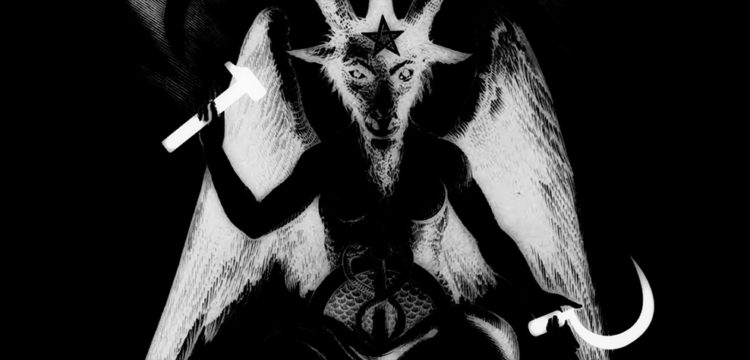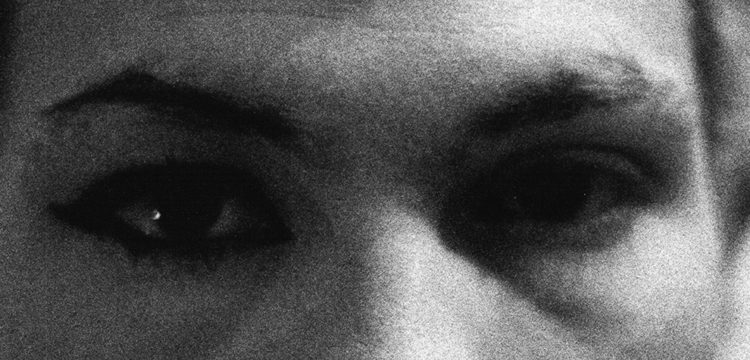Priestess of Love
Valentine Tanz aka Vala T.Foltyn on poetic revolution, witchcraft, shape shifting and queer mourning
Valentine Tanz/Vala T. Foltyn is a poetic choreographer, queer witch, priestess of love, disobedient shape-shifter, devotional singer, visual mythology artist and political activist. She graduated in Cultural Anthropology from Jagiellonian University in Kraków in Poland, at Performers House in Denmark and Artness by Shahar Dor in Israel. In 2018 she was running a political campaign to become the mayor of the city of Kraków as gender non-binary person. In 2019 she fled to Copenhagen due to violence against LGTBQ people in Poland. Recent works of her have been shown in numerous international contexts, including Bergen Assembly, Shelter Festival in Helsinki, XXI Międzynarodowy Festiwal Sztuki Interakcje Poland, Salzburg Strike Gently Away, Body Landscapes Performance Art Festival in Copenhagen.
Ginevra Ludovici: In your artist statement you define yourself as “poetic choreographer, queer witch, priestess of love, disobedient shape-shifter, devotional singer, visual mythology artist and political activist.” So many different things interconnected in one single person. How would you describe your practice?
Valentine Tanz/Vala T. Foltyn: I define my practice mostly as poetic choreography. It developed over time as my own method and vision of the work. It derives from thinking choreography: thinking time-space-body. By “poetic” I mean deriving from language, from imagination, from the process of articulating thoughts. By poetic I also mean loving, sensual, vulnerable and “naive.” I am at this moment in my life where I am not interested in fighting but in doing a tender revolution, that’s why is called poetic, and often it refers to magic as well.
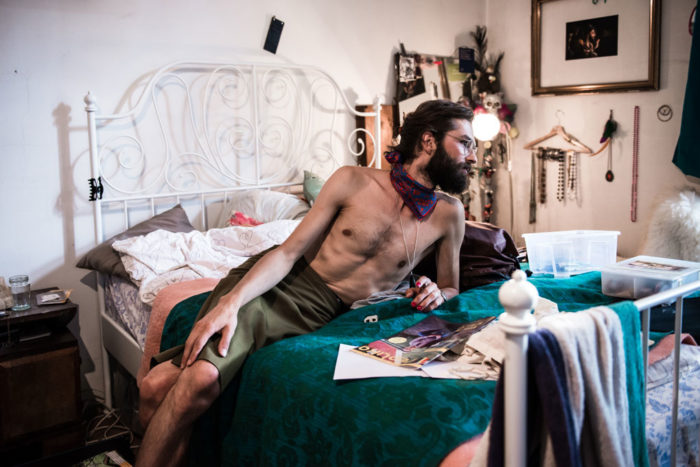
Valentine Tanz/Vala T. Foltyn, Krakow Art House, Krakow, Poland. Photo Mikołaj Perełkiewicz.
When did you first realize that you wanted to work as an artist (and all the other things)?
Always! Since I was a kid I was involved in theater-making, it happened I was part of this avant-garde poetic theater in my hometown (Terminus a Quo), where I gained knowledge about body movement, improvisation, poetry and literature. I come from a working class family and art was never talked about in my house, only later I discovered the history of my further ancestors, who were artists before the II WW started. Also, I never wanted to study at the theater academy, I knew this was not my way, and so I applied for anthropology of culture, because I was interested in how the culture operates and how it also can be a great source of knowledge for an artist, to understand society, politics and culture. I wrote my thesis on dance and used self-anthropology as methodology. At that time at my university it was something very new, to write from my own perspective and experience, which is also a very feminist method, luckily it was supported back then, at my department in Kraków. When I was studying history of dance I was very interested in Anna Halprin’s work, and I travelled later on to meet her in San Francisco, that’s where I experienced her work and teaching. She’s one of the biggest inspiration in my life as nonconforming artist, and also a dear friend. In a way as we were talking before about the story of Anna, she opened up the word of performance to me. Thanks to her I understood that repeating mechanically steps on stage is not a point, but the most important key is to share intimate stories and feelings. It manifests in the body but also in the aesthetics, and it has the power to be transformed. Yes, so: how did I become all these things? Life experience. I was never a person who would just be interested in one thing. +
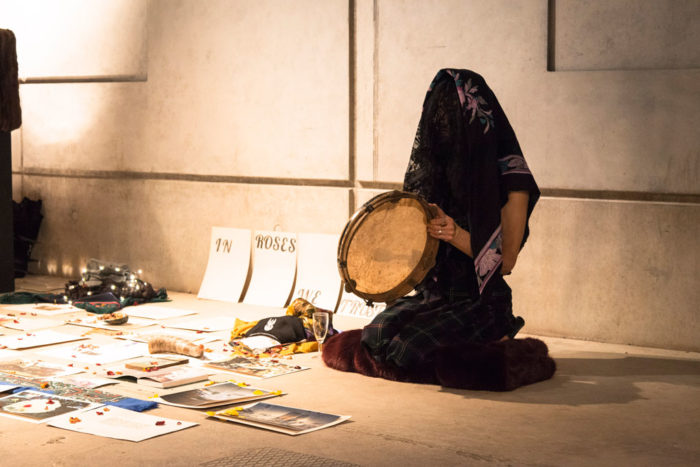
Strike Gently Away, Stuttgart, Germany, 2019. Photo Florian Model.
It seems like a process a continuous redefinition of yourself, in which the limits between art and life are blurred. It reminds me of the Foucaultian concept of “aesthetics of existence,” in which one’s life is conceived as a construction in which many factors intervene and, for this reason, also a fundamental field of battle, that is necessary to make your own in a creative and daily-life work of self-transformation with the aim of inventing new possibilities of existence and resistance. It is about a constant self-constitution process that is also visible in one’s own body and that, thus, can work as a potential transformation of the experience of the observer.
My life indeed is a constant redefinition, self-questioning and I think that’s why I arrived with the identity of being a witch, which is what I am busy with at the moment. And that’s why the shape shifting. I believe change to be the most powerful resisting force.
Witchcraft opens up to so many new things, new ways of seeing. The shape shifting is not just an existential statement, but also becomes part of my aesthetics, to then go to gender identity, as a non-binary person, trans-fem, queer creature. Change fuels my art. How do we shape shift our bodies and identities? How do things change when you look at them, how can you manipulate the image with certain gestures or textiles, or the state of your body? How do you become something else? My spirit is female, my body is male. So this is a great source for researching throughout my practice: what does it mean to be a woman? What is manhood? What is the space in between? It is not about knowing.
These days are crazy, we are witnessing this madness in the world: the right turn in politics, fascisms and the apocalypse of climate tragedy. I can sense darkness everywhere, and this darkness shapes my mind. But there is a lightness I am interested in seeing. The heart, the healing practice: how does this darkness become lightness? How does sadness turn into joy? How does the shade become my force?
This past year was very important in my life, not just as an artist but as a human being. Due to gentrification and the conflict with the investor I lost my house. At the same time I lost my dearest friend, Aneta Żukowska (writer, journalist, producer of my shows), who passed away because of cancer. So the loss and death became part of my reality. Our culture is completely disconnected from feelings, hence from grieving and mourning. We avoid to face death, we deny to feel the loss and anger that come with it. So, my practice became a practice of queer mourning, a lamentation, an elegy or litany. I also find myself caught in this process, as in a path to liberation. At a certain point, when you lose everything, you have the chance to set yourself free. And freedom is no fear, following Nina Simone’s words.
I also think that within queer identity, death is such a big part of what we are. If we look closer into the history of queers we see violence, discrimination, murders, AIDS crisis. Also, the majority of queer people are born in straight families, in many cases we do not have queer mothers or fathers. Oftentimes, we need to create our own new families and tribes, because our biological families have trouble accepting us. We are dealing with loss all the time. So my practice offers a space for transformation. It is a ritual, where we have a chance to come together as a community and hopefully start the healing. I could also talk more about the problematics of the word “healing”—since there is such a denial in the art world for any spiritual practice. But, it would be a waste of time and energy to go into details.
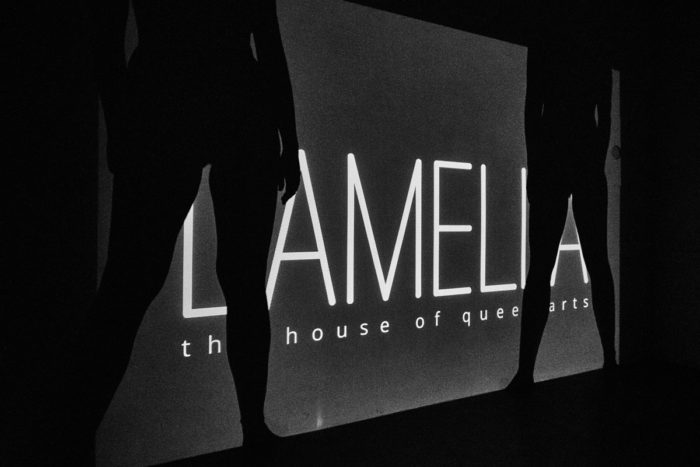
Lamella – the house of queer arts, Krakow, Poland. Photo Klaudyna Schubert.
In relation to this, you are the co-founder of Kraków Art House, an artist-run independent art/cultural space located in the heart of Kraków, and of the collective Lamella – The House of Queer Arts. Could you tell me more about these projects?
Kraków Art House was founded in 2016 together with a friend of mine I was sharing the house with. We were living in this old house, built in 1907, and at some point we realized that there was a certain gap in our city, in terms of cultural life. My agenda was to create a space for queer and feminist artists, but also to have a community space, a loving and supporting environment for radical and avant-garde works. So, Kraków Art House was the space of the villa, which was having regular openings of exhibitions and art related events run by locals. Lamella – The House of Queer Arts was created even before KAH, it was a queer and friendship based collective. Lamella consisted in a group of queer people of various gender and cultural backgrounds. We were interested in developing alternative forms of feminist and queer practices, as well as transnational tools for art and community making, as a response to hyper capitalistic notions of exclusion, productivity and labor. It was a pop-up space and at some point it just merged with the Kraków Art House. Right now, Lamella is working on a new collective in Copenhagen, and is just about to open its doors in December, in a former church in Nørrebro.
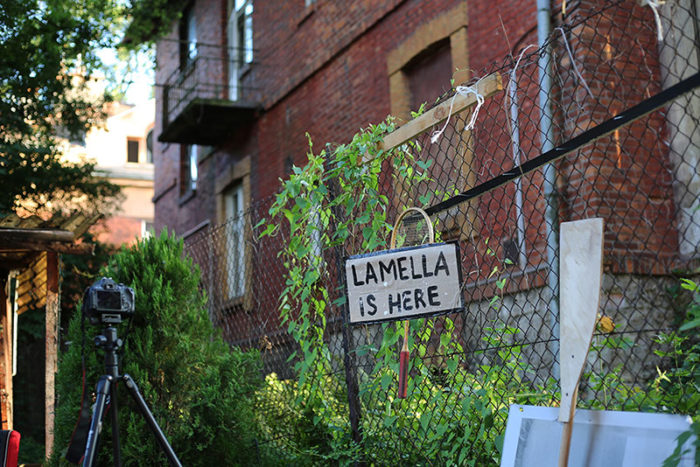
Lamella – the house of queer arts, Krakow, Poland. Photo Patrycja Gotszling.
There was no alternative in the scene?
No, there was not. There was nothing like Lamella or Kraków Art House. It was truly a unique platform that attracted so many people because of its magic. I think it was one of the first openly queer space dedicated to contemporary art practices in Poland. The most relevant thing for me was to host events in my house, it has always been my dream to run a space on my own terms with like-minded friends. I withdrew from the art scene and disconnected with the central point in Poland—Warsaw, where everything was happening. At the same time, I wanted to create a space that would not compromise with neoliberal modes of production and aesthetics. I wanted to be free from competitiveness and career rush. I was looking for original ideas that like mine, would derive from personal stories, from unique experiences and dreams. My idea was to make this local space vibrant, queer and truly avant-garde. And it was a great success.
So, coming from a choreography background, I was working with my friends more by choreographing the community, meaning dealing with time, in the sense of running events that do not have a defined time frame—for instance by announcing that things would start after sunset and end before the sunrise. We were working with poetic notions of time and space. It was a space, actually a home, where you could stay after the event, where you could really talk and exchange thoughts, where you could also date, flirt, and sometimes even make love.
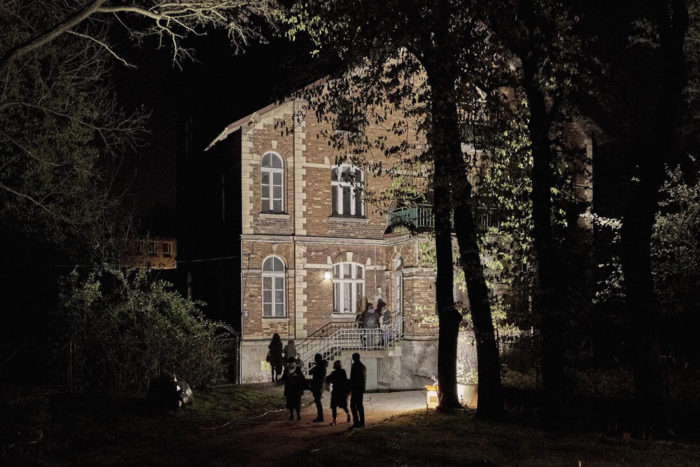
Exterior of the House, Krakow Art House, Krakow, Poland. Photo Jacek Maria Stokłosa.
In 2018, Kraków Art House was closed down. Why?
It was closed down last year due to the gentrification process and conflicts with the investor, which was a personal tragedy for me because I offered them to collaborate and work with the heritage of the house. My idea was to make this place a unique space in the city, different from other gentrified areas, hotels and hipster locations. They were interested in developing a project with me and I was aiming for a space that would include contemporary art and a healing center, as well as a constant work with the community. We were already having discussions about it and it seemed like a great project to carry out together. But in the end they decided to move on without me, without respecting my authorship rights. I brought the case to the court and of course failed. It was a very exhausting procedure for me.
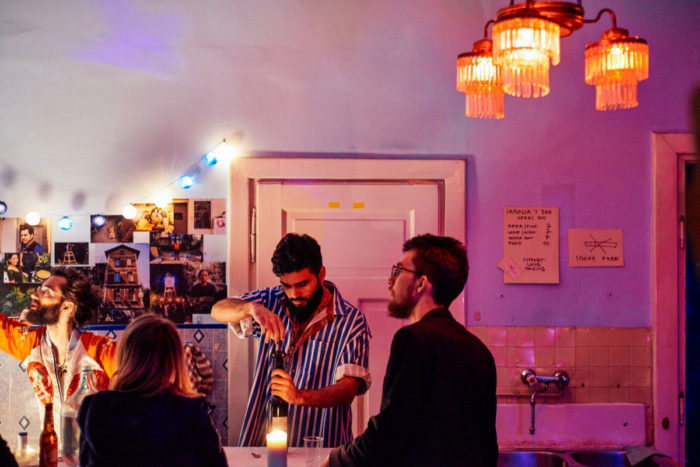
Interior of the House, Krakow Art House, Krakow, Poland. Photo Klaudyna Schubert.
The notion of “house” implies a hospitable relation, which you constructed in your time at the Kraków Art House. In recent years the notion of hospitality has started to be used as a curatorial framework to analyze the current sociopolitical context. Whoever claims curatorial responsibility can appear in the role of host, while the invited—artists, audiences but also exhibits—can take on that of the guest. These roles continuously change in relation to one another, implying asymmetries and dependencies. How was your experience in being both an artist and a curator? Which are the limits and the spaces for possibilities for this twofold role?
I found myself being the mother of the house and of the Lamella collective, a role that I truly enjoyed. Being the host/curator was sometimes exhausting, because it involved both the conceptual and the practical work. The production in a house as such demands special care and time. It was a one hundred years old house, with no elevator. Imagine the staircase! The practice of hosting had a strong impact on my artistic research. It naturally became part of it, and I see my performances as curating experiences. It is also interesting to look at the roles of hosts and guests, try to switch them, make others take the initiative, play with tasks and responsibilities. As a host you get to gain certain knowledge of the production, so you can easily understand what artists need to deliver in their work and what audiences need to feel safe/home. Moreover, the functions of host/guest were also embodied by the public: we made people fall in love with the house, so they could also feel responsible for the space and contribute with their ideas. They did follow the choreography of the house and its magic. This does not happen—and will never happen—in the institutional spaces of art. I am very thankful to the community that created this space, it was truly one of the most beautiful and creative time of my life.
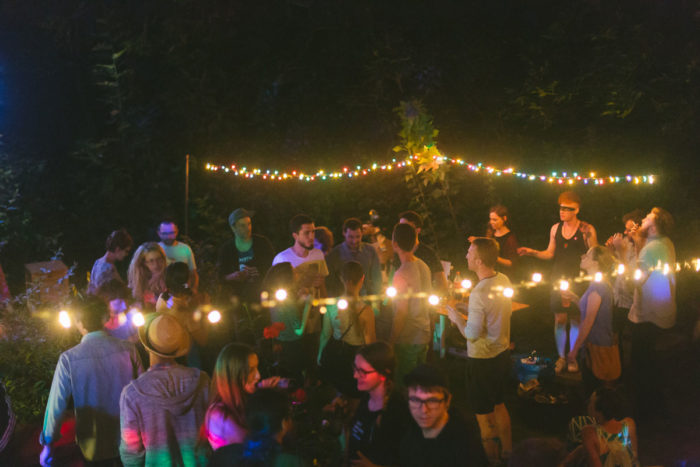
Exterior of the House, Krakow Art House, Krakow, Poland. Photo Bartolomeo Koczenasz.
What was the history of the house?
The house was built in 1907. It is located in the Dębniki district, walking distance from the Kraków’s Wawel Castle. The members of Truszkowski family were significant people in the local culture and art scene—a pianist, a photographer, an actress, a theatre teacher, a priest and many more were frequent visitors of the house. During WWII, under Kraków’s Nazi occupation, the house was a place of secret meetings of the female brigade of Home Army of Poland. Maria, the mother of the house, kept the photographs of her friends in her cooking book, which I found when I moved into the house. The history unfolded from the recipes and old photographs. The family shared the garden with Karol Wojtyła in the 30s, who lived around the corner and later become Pope—Jan Paweł II. The other neighbor was a philosopher, Wincenty Lutosławski, who did a chronology of Plato’s works and later on translated yoga scripts into Polish language. He was devoted to philosophy, spirituality and social activism. This house has an amazing history that was slowly being revealed to me, as I research and work on their archives. Some stories and items from the house became part of my lecture performances and installations.

Reading of Aneta Żukowska with Lamella, Krakow Art House, Krakow, Poland. Photo Patrycja Gotszling.
As you were mentioning before, in 2018 you presented yourself as the first gender fluid/gender non-binary candidate for the position of the Mayor of the City of Kraków in Poland. Why did you decide to enter into politics?
My decision of running the campaign for the position of the Mayor of Kraków was a strategy to bring into public debate the experiences of gentrification, injustice and violence I faced during these recent years. Poland became a really hard place to live for trans and queer people. Hate speech in political debates, but also problems of safety in public spaces led me to this decision. At the same time I was simply angry and I knew this might be my last project in Kraków. I decided to bet everything on one card, and I knew this was an irreversible decision. I gained a lot of visibility in the media and took space in political debates. It was short and intense appearance. My strategy was only to trigger, question and shake people’s minds. I wanted to speak my truth and let everyone know about my struggles, yet to disclose how powerless one can be if the country turns into a fascist state. I am also glad that my political views and experiences pushed other politicians to support my voice and stand for the rights of LGTBQ community. I still think that gentrification is the most cruel result of neoliberal politics, which almost every city is facing right now. It creates class divisions, it makes people homeless and it truly destroys local communities’ life.
There are many of us, we only need to find each other in this precarious ocean of hopelessness. We shall unite, support and create new ways of being and claiming our spaces.
What were the consequences of this choice?
After receiving multiple life threats and harassments, I understood that my time in Poland was over and I decided to move to Copenhagen to start everything from the beginning. My disappointment is not only directed towards the politicians, but also towards the art world. It was a big exam for the art community to show their support, since I was running this campaign not only as queer activist but also as an artist. I guess it is going to take years until the art world in Poland will understand my steps. Maybe Poland will never be ready for the revolution of the witch who queered national patriotism and stood for the protection of national heritage and trans identity. Who else, if not the witch is to speak her truth and question the power? Speaking the truth was liberating and satisfying. Standing for my own basic human rights was my duty. Now it is time to heal and share my truth as part of my art.
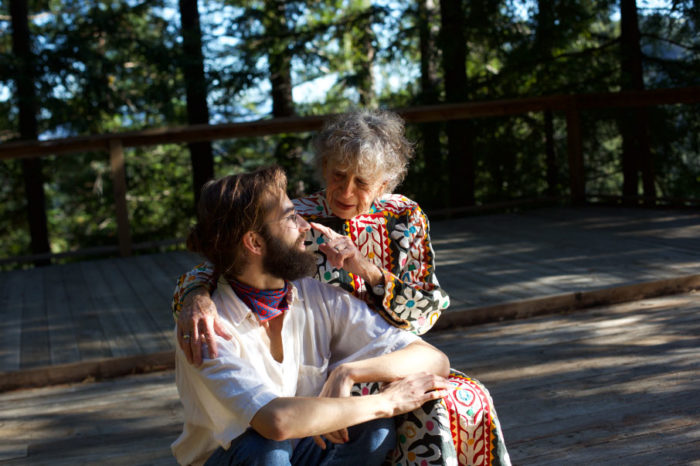
Anna Halprin and Valentine Tanz/Vala T. Foltyn, San Francisco, USA, 2017. Photo Bartolomeo Koczenasz.
As you were mentioning before, you are continuing the work with the Lamella collective in the neighborhood of Nørrebro, Copenhagen. What is on your agenda?
Copenhagen is a great place to recover and heal, and to be frank with you, that’s where I am right now. In some ways the exile from Poland was necessary and it was the only choice I had, on the other hand it is a traumatic experience still to be processed. I left in the midst of fire, leaving many things behind and knowing that I won’t be able to come back for a long time as the fascists took the country again in recent elections. But that’s behind me, and the future hopefully will be brighter. I am already building some new bonds here, connecting with locals and activating new spaces. I have a strong desire to show my work, share my experiences and open up discussions about the politics of current practices. I would like to meet other artists and makers and create solidarity around our struggles. There are many of us, we only need to find each other in this precarious ocean of hopelessness. We shall unite, support and create new ways of being and claiming our spaces. Not only in terms of social spaces, but also in terms of contemporary art discourse. Copenhagen is welcoming and ready to host the witch. I am also very busy with my own artistic practice. I am devoted now to work with the legacy of the villa from Kraków, as well as witchcraft as political resistance and artistic strategy. Let’s see what will happen in the coming future.


